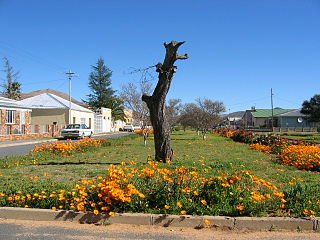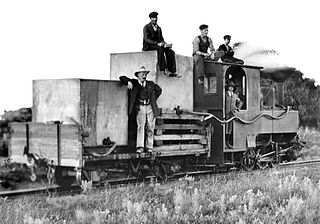

The Cape Government Railways (CGR) was the government-owned railway operator in the Cape Colony from 1874 until the creation of the South African Railways (SAR) in 1910.


The Cape Government Railways (CGR) was the government-owned railway operator in the Cape Colony from 1874 until the creation of the South African Railways (SAR) in 1910.
The first railways at the Cape were privately owned. The Cape Town Railway and Dock Company started construction from Cape Town in 1859, reaching Eerste River by 1862 and Wellington by 1863. Meanwhile, by 1864, the Wynberg Railway Company had connected Cape Town and Wynberg. For the moment, railway development at the Cape did not continue eastwards beyond Wellington because of the barrier presented by the mountains of the Cape Fold Belt.

The discovery of diamonds, and the consequent rush to Kimberley that started in 1871, gave impetus to the development of railways in South Africa. Shortly afterwards, in 1872, the Cape Colony attained responsible government under the leadership of Prime Minister John Molteno, who presented plans for an enormous network of railways to connect the Cape Colony's main ports to its interior and, importantly, to the diamond fields. [1] In his very first speech to the Cape Parliament he announced the purchase of all existing lines and the founding of the Cape Government Railways. [2] [3]
The announced expansion was to see the construction of a network over ten times more extensive than the total length of railway that existed in the whole of southern Africa at the time. [4] [5] The management of this system – which was to become the nucleus of the future South African Railways – initially fell under his Public Works Department, until July 1873, when Molteno established a separate Railway Department under the renowned engineer William Brounger. [6]
The first few rudimentary lines at Cape Town were built at dimensions close to 4 ft 8+1⁄2 in (1,435 mm) standard gauge , the British Empire's standard. However their width, designed for England's landscape, made it impossible at the time to penetrate the mountains of the rugged southern African escarpment. Most of the sub-continent was effectively landlocked. In 1871 Molteno had written to the British Governor of the Cape Henry Barkly about the gauge which was used to penetrate the mountainous terrain near Trieste in modern Italy, believing it would work in crossing the South African mountains. A narrower gauge enabled tighter turns and traversing steeper terrain. [7] When the first elected Cape government took power the next year, its select committee set the gauge for all new railways at 3'-6". [8] The use of a dual system was briefly kept, to ease the transition for the existing wider lines, but in only a few months the government standardised all railway development on what became known as the "Cape Gauge" of 3 ft 6 in (1,067 mm). [9]
Although it was first meant just to ease construction of railways through mountainous terrain, this gauge later went on to become the standard for all railways in southern and central Africa. [10] [11] [12]

The government's 1872 plan was for lines to strike northwards, from the three ports of Cape Town, Port Elizabeth and East London, towards Kimberley and the developing hinterland. These three lines became known as the "Cape Western", "Cape Midland" and "Cape Eastern" lines respectively. They were intended to bring the towns of southern Africa's vast hinterland into direct railway connection with the country's ports, thus driving the development of the interior and building an export economy.
The Cape Western Line was charted by the Prime Minister himself (allegedly with only a map, pen and ruler). [13] Cape Town was cut off from the highland interior by a triple barrier of steep mountain ranges, but the lines nonetheless progressed fast inland, once the primary obstacle of the Hex River Mountains was overcome in 1876 with a major system of bridges and tunnels. 1876 also saw the building of a new central station for Cape Town, and over the next few years the line was rapidly extended through the Karoo desert to the towns of Beaufort West, De Aar, and thence to Kimberley. [14]
The Cape Midland Line was begun in 1872, when the Cape Government took over the rudimentary and incomplete line of the Port Elizabeth and Uitenhage Railway Company. However building accelerated massively over the next few years, with twin lines reaching northwards to Graaff-Reinet, and eastwards to Grahamstown. These connected with the Cape Western Line at De Aar and thus to Kimberley. [15]
The Cape Eastern Line was built partially to serve the frontier, and its network of military forts. The port of East London was likewise chosen partly for strategic reasons, being the closest port to the frontier for landing and transporting troops. The line was begun in 1873, when the Prime Minister turning the first spades for both the East London harbour and the Eastern Railway Line on 20 August 1873. Though frontier wars disrupted construction from time to time, the line reached Queenstown in 1880. [16]

By 1885 the separate sections were connected and the Cape Western line reached Kimberley, marking the end of an epic which had begun in 1872, with the network completed faithfully according to the original 1872 plans. [17] From an initial total of 92 kilometres in 1872, the Cape was now criss-crossed with over 2,000 kilometres of railway. [18] [19]
Considerable development and economic growth followed the construction of the railway system, and the news of the Cape's immense railway programme inspired similar moves in neighbouring states, such as the project of the Natal Government Railways to extend its few miles of railway inland towards the Drakensberg, and President Burgers' ill-fated attempt to link the Transvaal Republic to Lourenço Marques.

In 1886 gold was discovered in the South African Republic (the Transvaal), setting off the Witwatersrand Gold Rush. The Cape government and the government of the Orange Free State (OFS) reached an agreement, by which the Cape Government Railways would build and operate a railway line, through the OFS, to the rapidly growing city of Johannesburg. This line reached Bloemfontein (the capital of the OFS) in 1890, and the first trains operated from Cape Town to Johannesburg in 1892. In 1897 the OFS government took over control of its portion of the line.
The Cape railway network played a significant role in supporting and supplying the British forces during the Second Boer War. After the war, when the Union of South Africa was formed in 1910, all railways in South Africa, including the CGR, the Natal Government Railways and the Central South African Railways, were taken over by the newly formed South African Railways (SAR).
According to a 2017 study, "Built largely to support the early mining industry, the Cape Colony’s railway substantially reduced the cost of transport to the interior and account for 22–25 percent of the increase in the Colony’s labor productivity from 1873 to 1905... traffic data for 1905 suggest that the railway contributed to the expansion of the mining areas and to the growth of the Western Cape district on the basis of domestic demand." [20]

Under the Whyte notation for the classification of steam locomotives, 0-4-0 represents one of the simplest possible types, that with two axles and four coupled wheels, all of which are driven. The wheels on the earliest four-coupled locomotives were connected by a single gear wheel, but from 1825 the wheels were usually connected with coupling rods to form a single driven set.
The Netherlands–South African Railway Company or NZASM was a railway company established in 1887. The company was based in Amsterdam and Pretoria, and operated in the South African Republic (ZAR) during the late 19th century. At the request of ZAR president Paul Kruger, the NZASM constructed a railway line between Pretoria and Lourenço Marques in Portuguese East Africa.
The following lists events that happened during 1881 in South Africa.
The following lists events that happened during 1882 in South Africa.
The following lists events that happened during 1873 in South Africa.
The following lists events that happened during 1875 in South Africa.

Railways with a track gauge of 3 ft 6 in were first constructed as horse-drawn wagonways. The first intercity passenger railway to use 3 ft 6 in was constructed in Norway by Carl Abraham Pihl. From the mid-nineteenth century, the 3 ft 6 in gauge became widespread in the British Empire. In Africa it became known as the Cape gauge as it was adopted as the standard gauge for the Cape Government Railways in 1873, although it had already been established in Australia and New Zealand before that. It was adopted as a standard in New Zealand, South Africa, Indonesia, Japan, the Philippines, Taiwan, and Queensland in Australia.

The four Hex River Tunnels consist of a twin tunnel of 0.5 kilometres and three single tunnels of 1.1 kilometres, 1.2 kilometres and 13.5 kilometres, on the Hexton railway route between De Doorns and Kleinstraat through the Hex River Mountains of the Western Cape Province, South Africa. The line, which connects De Doorns in the Hex River valley with Touws River in the Great Karoo, is part of the main rail route between Cape Town and Johannesburg. Of the 30 kilometres of track, 16.8 kilometres are underground. Construction of the line eliminated the bottleneck of the Hex River rail pass.
Port Elizabeth railway station is a railway station, located in Port Elizabeth, South Africa.

Touws River is a small railway town of 8,126 people in the Western Cape province of South Africa. It is located on the river of the same name, about 160 kilometres (100 mi) north-east of Cape Town. The Touwsrivier CPV Solar Project is located just outside of the town and supplies 50 MW to the national electrical grid.

Leeu-Gamka is a small town in the Western Cape province of South Africa, located 355 kilometres (221 mi) north-east of Cape Town in the Karoo.

The Cape Town Railway & Dock 0-4-0T of 1859 was a South African steam locomotive from the pre-Union era in the Cape of Good Hope, and the first locomotive in South Africa.

James Bisset was an architect and civil engineer of the Cape Colony, responsible for many of the Cape's early buildings and communications infrastructure. He was also Mayor of Wynberg, South Africa.

The Cape Town Railway & Dock 0-4-2 of 1860 was a South African steam locomotive from the pre-Union era in the Cape of Good Hope.

The Cape Town Railway & Dock 2-4-0T of 1864 was a South African steam locomotive from the pre-Union era in the Cape of Good Hope.

The Cape Government Railways 0-4-0ST 1881 Coffee Pot was a South African steam locomotive from the pre-Union era in the Cape of Good Hope.

The Cape Government Railways 2nd Class 4-4-0T of 1882 was a South African steam locomotive from the pre-Union era in the Cape of Good Hope.

The Cape Government Railways 0-4-0ST of 1873 was a South African steam locomotive from the pre-Union era in the Cape of Good Hope.

The Cape Government Railways NG 0-6-0T of 1903 was a South African steam locomotive from the pre-Union era in the Cape of Good Hope.

The Cape Government Railways NG 4-6-2T of 1908 was a South African narrow-gauge steam locomotive from the pre-Union era in the Cape of Good Hope.